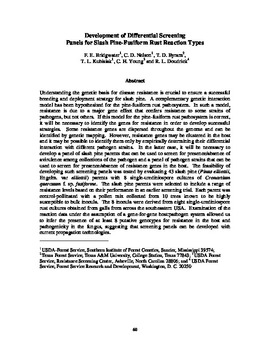| dc.contributor.author | Bridgewater, F. E. | |
| dc.contributor.author | Nelson, C. D. | |
| dc.contributor.author | Byram, T. D. | |
| dc.contributor.author | Kubisiak, T. L. | |
| dc.contributor.author | Young, C. H. | |
| dc.contributor.author | Doudrick, R. L. | |
| dc.date.accessioned | 2016-04-25T19:35:56Z | |
| dc.date.available | 2016-04-25T19:35:56Z | |
| dc.date.issued | 2003 | |
| dc.identifier | oksd_sf27_p060.pdf | |
| dc.identifier.citation | Bridgewater, F. E., Nelson, C. D., Byram, T. D., Kubisiak, T. L., Young, C. H., & Doudrick, R. L. (2003). "Development of Differential Screening Panels for Slash Pine-Fusiform Rust Reaction Types." In 27th Southern Forest Tree Improvement Conference, Stillwater, OK | |
| dc.identifier.uri | https://hdl.handle.net/11244/33660 | |
| dc.description.abstract | Understanding the genetic basis for disease resistance is crucial to ensure a successful breeding and deployment strategy for slash pine. A complementary genetic interaction model has been hypothesized for the pine-fusiform rust pathosystem. In such a model, resistance is due to a major gene effect that confers resistance to some strains of pathogens, but not others. If this model for the pine-fusiform rust pathosystem is correct, it will be necessary to identify the genes for resistance in order to develop successful strategies. Some resistance genes are dispersed throughout the genome and can be identified by genetic mapping. However, resistance genes may be clustered in the host and it may be possible to identify them only by empirically determining their differential interaction with different pathogen strains. In the latter case, it will be necessary to develop a panel of slash pine parents that can be used to screen for presence/absence of avirulence among collections of the pathogen and a panel of pathogen strains that can be used to screen for presence/absence of resistance genes in the host. The feasibility of developing such screening panels was tested by evaluating 43 slash pine (Pinus elliottii, Engelm. var elliottii) parents with 8 single-urediniospore cultures of Cronartium quercuum f. sp. fusiforme. The slash pine parents were selected to include a range of resistance levels based on their performance in an earlier screening trial. Each parent was control-pollinated with a pollen mix collected from 10 trees known to be highly susceptible to bulk inocula. The 8 inocula were derived from eight single-urediniospore rust cultures obtained from galls from across the southeastern USA. Examination of the reaction data under the assumption of a gene-for-gene host:pathogen system allowed us to infer the presence of at least 8 putative genotypes for resistance in the host and pathogenicity in the fungus, suggesting that screening panels can be developed with current propagation technologies. | |
| dc.format | application/pdf | |
| dc.language | en_US | |
| dc.relation.ispartofseries | Sponsored publication . . . of the Southern Forest Tree Improvement Committee ; no. 49 | |
| dc.rights | This paper is made available through open access and the auspices of the fair use doctrine for scholarly, educational and research purposes while recognizing the publisher already offers a free online version. The OSU Library�s intent is to offer access and preserve publications involving its faculty contributions. Contact the Digital Resources and Discovery Services at lib-dls@okstate.edu or 405-744-9161 for the permission policy on the use, reproduction or distribution of this material. | |
| dc.source | Proceedings of the 27th Southern Forest Tree Improvement Conference, volume 27, 2003. Editor, Craig R. McKinley. | |
| dc.title | Development of Differential Screening Panels for Slash Pine-Fusiform Rust Reaction Types | |
| dc.type | text | |
| osu.filename | oksd_sf27_p060.pdf | |
| dc.type.genre | Conference proceedings | |
| dc.description.scopeandcontents | Papers and abstracts from the 27th Southern Forest Tree Improvement Conference held at Oklahoma State University in Stillwater, Oklahoma on June 24-27, 2003. | |
